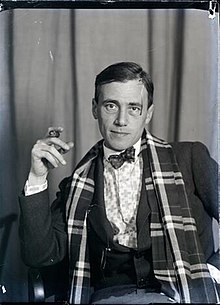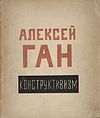art.wikisort.org - Artist
Hans Richter (6 April 1888 – 1 February 1976) was a German Dada painter, graphic artist, avant-garde film producer, and art historian. In 1965 he authored the book Dadaism about the history of the Dada movement.[1] [2] He was born in Berlin into a well-to-do family and died in Minusio, near Locarno, Switzerland.[3]
Hans Richter | |
|---|---|
 Richter c. 1928 | |
| Born | 6 April 1888 Berlin, Germany |
| Died | 1 February 1976 (aged 87) Minusio, Switzerland |
| Occupation | Painter, graphic artist, avant-gardist, film maker, animation producer |
| Years active | 1914–1961 |
| Spouse | Meta Erna Niemeyer (aka Ré Soupault) |
From Expressionism through Dadaism, Constructivism and Neoplasticism, he was one of the major figures of avant-garde art in the 1910s and 1920s[3] and a catalyst for intellectuals and artists in many disciplines. Richter helped organise exhibitions which revived interest in Dada, both in the United States and Europe. In 1956 he made Dadascope, a film dedicated to Dada poetry.
Germany
In 1908 Richter entered the Academy of Fine Art in Berlin, and the following year the Academy of Fine Art in Weimar. Richter's first contacts with Modern Art were in 1912 through the Blaue Reiter and in 1913 through the Erster Deutscher Herbstsalon gallery Der Sturm, in Berlin. In 1914 he was influenced by Cubism.
At that time he also befriended Franz Pfemfert, who was the editor of Die Aktion.[4] Richter contributed to the periodical Die Aktion in Berlin.[5] His first exhibition was in Munich in 1916, and Die Aktion published a special edition about him. In the same year he was wounded and discharged from the army and went to Zürich and met Tristan Tzara, Marcel Janco, Jean Arp, and Hugo Ball, who together were forming the Dada movement, which he joined.
Richter believed that the artist's duty was to be politically active by opposing war and supporting revolution. His first abstract art works were made in 1917. In 1918, Tristan Tzara introduced Richter to Viking Eggeling and the two experimented together with film. Richter was co-founder, in 1919, of the Association of Revolutionary Artists (Artistes Radicaux) at Zürich. In the same year he created his first Prélude: an orchestration of a theme developed in eleven drawings. In 1920, he became a member of the November Group in Berlin and contributed to the Dutch periodical De Stijl.
Throughout his career, Richter claimed that his 1921 film, Rhythmus 21, was the first abstract film ever created, but in fact it was preceded by the Italian Futurist films by Bruno Corra and Arnaldo Ginna[6] (as they report in the Futurist Manifesto of Cinema),[7] as well as by fellow German artist Walter Ruttmann, who produced Lichtspiel Opus 1 in 1920. Nevertheless, Richter's film Rhythmus 21 is considered an important early abstract film.
In 1933, The Nazis ransacked Richter's studio in Berlin, confiscating or destroying his work. He was stripped of his German citizenship and labelled a "degenerate" artist and "cultural Bolshevik". After attempting, in vain, to make an anti-Nazi film in the Soviet Union in 1931–1932, Richter travelled around Europe. He worked for Philips in Holland and made commissioned films in Switzerland. He also gave numerous lectures about film.
About Richter's woodcuts and drawings Michel Seuphor wrote that Richter's black-and-whites graphic work, together with that of Hans Arp and Marcel Janco, are the most typical works of the Zürich period of Dada. From 1923 to 1926, Richter edited, together with Werner Gräff and Mies van der Rohe, the periodical G. Material zur elementaren Gestaltung. Richter wrote of his own attitude toward film:
I conceive of the film as a modern art form particularly interesting to the sense of sight. Painting has its own peculiar problems and specific sensations, and so has the film. But there are also problems in which the dividing line is obliterated, or where the two infringe upon each other. More especially, the cinema can fulfill certain promises made by the ancient arts, in the realization of which painting and film become close neighbors and work together.
United States
Richter moved from Switzerland to the United States in 1940 and became an American citizen. Beginning in 1941 he taught at the Institute of Film Techniques at the City College of New York before taking over as director.[8] While living in New York City, Richter directed two feature films, Dreams That Money Can Buy (1947) and 8 x 8: A Chess Sonata in 8 Movements (1957) in collaboration with Max Ernst, Jean Cocteau, Paul Bowles, Fernand Léger, Alexander Calder, Marcel Duchamp, and others, which was partially filmed on the lawn of his summer house in Southbury, Connecticut. In 1957, he finished a film entitled Dadascope with original poems and prose spoken by their creators: Hans Arp, Marcel Duchamp, Raoul Hausmann, Richard Huelsenbeck, and Kurt Schwitters. After 1958, Richter spent parts of the year in Ascona and Connecticut and returned to painting. Peggy Guggenheim organized his first solo show in the United States in which his large painted scrolls, inspired by the Second World War, featured prominently.[8] In 1963, he directed the short film From the Circus to the Moon about the American artist Alexander Calder.[9] In 1965, Richter was also the author of a first-hand account of the Dada movement titled Dada: Art and Anti-Art[10] which also included his reflections on the emerging Neo-Dada artworks.[citation needed]
Personal life
Richter got to know Ré Niemayer in 1922, whom he would marry in 1926.[11] In 1928, the two separated[12] and by 1931 they were divorced.[11]
Filmography
- Rhythmus 21 (1921)
- Rhythmus 23 (1923)
- Rhythmus 25 (1925)
- Filmstudie (1926) with music by Hans Heinz Stuckenschmidt
- Inflation (1927)
- Vormittagsspuk ("Ghosts Before Breakfast", with music by Hindemith) (1928)
- Zweigroschenzauber (1929)
- The Storming of La Sarraz (written only, directed by Sergei Eisenstein, lost) (1929)
- Rennsymphonie (1929)
- Alles dreht sich, alles bewegt sich (1929)
- Everyday (1929)
- Neues Leben (1930)
- Europa Radio (1931)
- Hallo Everybody (1933)
- Keine Zeit für Tränen (1934)
- Vom Blitz zum Fernsenhbild (1936)
- Dreams That Money Can Buy (1947)
- 8 x 8: A Chess Sonata in 8 Movements (1957)
- Dadascope (1961)
- From the Circus to the Moon (1963)
See also
- Anti-art
- Experimental film
- Animation
- Dada
- Art intervention
- List of Dadaists
- Épater la bourgeoisie
Notes
- Hans Richter, Dadaism, New York: Thames and Hudson, 1965
- "Magazine Features – Hans Richter, Dada Pioneer". Artnet.com. Retrieved 18 August 2014.
- Oxford Dictionary of Modern and Contemporary Art, Oxford University, p. 598
- "Hans Richter". Retrieved 19 August 2022.
- Haftmann, Werner (1978). Postscript to Dada: Art and Anti-Art. Thames & Hudson. ISBN 0-500-20039-4., p. 220
- Article on Futurist Cinema Archived 7 October 2002 at the Wayback Machine
- "'The Futurist Cinema' Manifesto, 1916". Unknown.nu. Retrieved 18 August 2014.
- Haftmann, p. 222
- "Historic Films – Calder Foundation". Retrieved 30 May 2017.
- Richter, Hans (1965). Dada: Art and Anti-Art. Thames & Hudson. ISBN 0-500-20039-4.
- "Ré Soupault". www.bauhauskooperation.de (in German). Retrieved 29 August 2021.
- Biographie, Deutsche. "Soupault, Ré (verheiratete) - Deutsche Biographie". www.deutsche-biographie.de (in German). Retrieved 29 August 2021.
References
- Stephen C. Foster, Hans Richter: Activism, Modernism, and the Avant-Garde (Cambridge, MA: MIT Press, 1998). ISBN 9780262561297. OCLC 43718368.
- Mark Purves and Rob McFarland, "Hans Richter: Biography" in: Christoph Bareither et al. (Eds.): Hans Richters "Rhythmus 21": Schlüsselfilm der Moderne.Königshausen und Neumann, Würzburg, 2012. ISBN 382604861X (Article in English).
- Hans Richter, 'Towards a New World Plasticism' in Mary Anne Caws, Manifesto: A Century of Isms (Lincoln, Nebraska and London: University of Nebraska Press, 2001).
Further reading
- Richard Suchenski, "Hans Richter", Senses of Cinema 49 (February 2009).
External links
- "From the Circus to the Moon" (1963) on YouTube
- Hans Richter at IMDb
- Hans Richter films at Ubuweb
- Hans Richter at YouTube
- Finding aid for Arnold Eagle papers and films related to Hans Richter, Getty Research Institute, Los Angeles. Accession No. 970021. This collection documents the film collaborations and friendship of German-born Dadaist, Hans Richter, and New York photographer and cinematographer, Arnold Eagle. It includes color film footage, out-takes and audiotracks for several of Richter's films, such as Dreams that Money Can Buy and 8 x 8 Chess Sonata in 8 movements.
На других языках
[de] Hans Richter (Dadaist)
Hans Richter (* 6. April 1888 in Berlin; † 1. Februar 1976 in Minusio, Schweiz) war ein deutscher Maler, Graphiker, Kunstschriftsteller und Filmkünstler.- [en] Hans Richter (artist)
[es] Hans Richter (pintor)
Hans Richter (Berlín, 6 de abril 1888-Muralto, 1 de febrero 1976) fue un pintor y cineasta alemán, nacionalizado más tarde estadounidense. Realizó los cortometrajes Rhythm 21 (1921), Rhythm 23 (1923) o Ghost before breakfast (1927), pieza de la cual los nazis destruyeron la versión sonora que había realizado Paul Hindemith. En 1928 abandona la pintura para dedicarse al cine. Desde 1942 hasta 1956 enseña cinematografía en el City College de Nueva York.[fr] Hans Richter (artiste)
Johannes Siegfried Richter dit Hans Richter, né le 6 avril 1888 à Berlin en Allemagne et mort le 1er février 1976 à Minusio dans le district de Locarno en Suisse[1], est un peintre, sculpteur et cinéaste[2] allemand, naturalisé américain en 1971[1].[it] Hans Richter (regista)
Hans Richter, pseudonimo di Johannes Siegfried Richter (Berlino, 6 aprile 1888 – Locarno, 1º febbraio 1976), è stato un regista, pittore e scrittore tedesco.[ru] Рихтер, Ханс (художник)
Йоханес Зигфрид Рихтер (нем. Johannes Siegfried Richter, или Ханс Рихтер нем. Hans Richter, 6 апреля 1888, Берлин — 1 февраля 1976, Локарно) — немецкий художник, график, кинорежиссёр-авангардист и теоретик кино.Другой контент может иметь иную лицензию. Перед использованием материалов сайта WikiSort.org внимательно изучите правила лицензирования конкретных элементов наполнения сайта.
WikiSort.org - проект по пересортировке и дополнению контента Википедии
